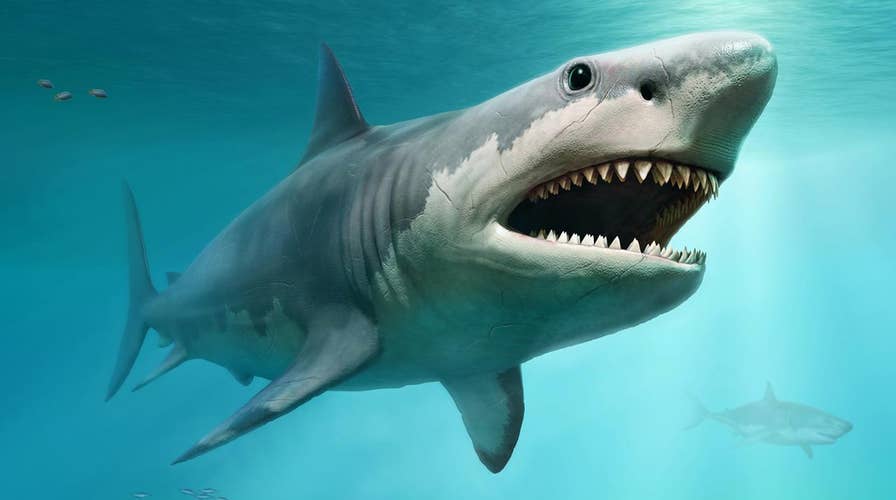A new study may explain why Megalodon went extinct
A new study suggests that Megalodon, the largest marine predator to ever live, may have gone extinct due to the giant shark's body temperature. As the oceans cooled, the sharks may have been forced to lower latitudes where ocean temperatures were warmer, while its prey evolved to withstand cooler temperatures of higher latitudes.
If the megalodon didn't cause itself to go extinct, it may have been the work of an ancient exploding star, a shocking new study theorizes.
Put forth by researchers Adrian Melott, Franciole Marinho and Laura Paulucci and published in the scientific journal Astrobiology, the study suggests that "one or more supernova" approximately 2.6 million years ago may have caused a mass extinction of a great number of marine megafauna, including the feared megalodon.
"We find that the radiation dose from the muons will exceed the total present surface dose from all sources at depths up to 1 [kilometer] and will persist for at least the lifetime of marine megafauna," the study's abstract reads. "It is reasonable to hypothesize that this increase in radiation load may have contributed to a newly documented marine megafaunal extinction at that time."
MEGALODON MAY HAVE GONE EXTINCT FOR THIS SHOCKING REASON
“One of the extinctions that happened 2.6 million years ago was Megalodon,” Melott said in a statement. “Imagine the Great White Shark in ‘Jaws,’ which was enormous — and that’s Megalodon, but it was about the size of a school bus. They just disappeared about that time. So, we can speculate it might have something to do with the muons. Basically, the bigger the creature is the bigger the increase in radiation would have been.”
Speaking with Motherboard, Melott said the radiation from the exploding stars, which could have been just 160 light years from Earth, may have been too much for the Earth's atmosphere and its creatures to handle.
“All of the historical supernovae that we know about over the last couple thousand years were much further away, so the effects would be tiny compared to this,” Melott told the news outlet.
Melott added that the muon spike could have caused mutations and cancers, especially for larger creatures not used to the levels of radiation from the accompanying supernova blast.
“Normally below a few meters [of the ocean surface], water really shields a lot of radiation but it wouldn’t shield the muons," Melott said. “Creatures that are used to being almost isolated from radiation would suddenly get a whole lot. They would be unlikely to have as good of a defense against radiation as land creatures would.”
There is evidence of the supernova, according to a number of research papers. In the aforementioned statement, Melott said he was even told as far back as the 1990s to be on the lookout for iron-60 isotopes, which are remnants of a supernova explosion.
PREHISTORIC SURVIVOR? HOW WE KNOW 'THE MEG' IS DEAD
“As far back as the mid-1990s, people said, ‘Hey, look for iron-60. It’s a telltale because there’s no other way for it to get to Earth but from a supernova.’ Because iron-60 is radioactive, if it was formed with the Earth it would be long gone by now," Melott said in the statement. "So, it had to have been rained down on us. There’s some debate about whether there was only one supernova really nearby or a whole chain of them. I kind of favor a combo of the two — a big chain with one that was unusually powerful and close. If you look at iron-60 residue, there’s a huge spike 2.6 million years ago, but there’s excess scattered clear back 10 million years.”
During the Pleistocene extinction event, many animals larger than 80 pounds went extinct, according to the Illinois State Museum. At roughly 60 feet in length, and a weight approaching 120,000 pounds, megalodons would have been a prime candidate to be affected by the cosmic blast.
NORTH CAROLINA COUPLE SPOT MASSIVE MEGALODON SHARK TOOTH ON BEACH
“There really hasn’t been any good explanation for the marine megafaunal extinction,” Melott said. “This could be one. It’s this paradigm change — we know something happened and when it happened, so for the first time we can really dig in and look for things in a definite way. We now can get really definite about what the effects of radiation would be in a way that wasn’t possible before.”
Earlier this week, another group of researchers theorized that the megalodon may have caused itself to go extinct.
The scientists suggested that its high body temperature (when compared to modern day sharks and a "cooling of ocean temperatures during the Pliocene would have constrained the species to lower latitudes where ocean temperatures were warmer, whilst its preferred prey (e.g., whales) evolved traits to adapt to cooler temperatures of the higher latitudes."
Follow Chris Ciaccia on Twitter @Chris_Ciaccia

